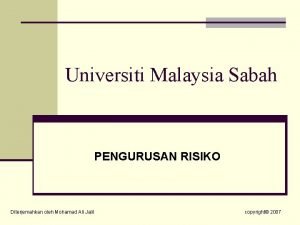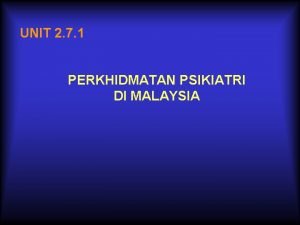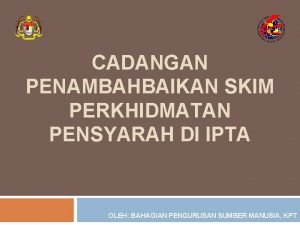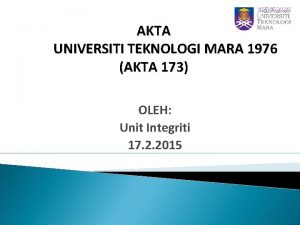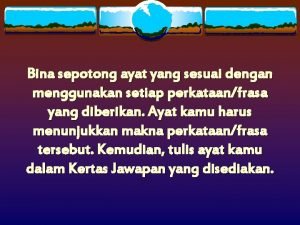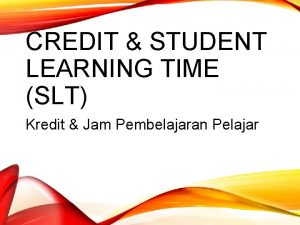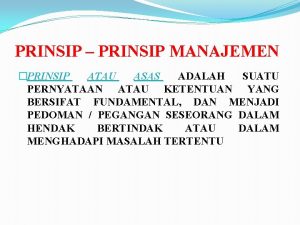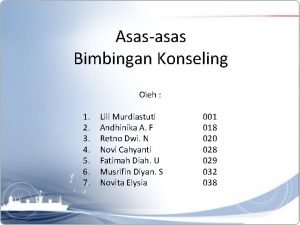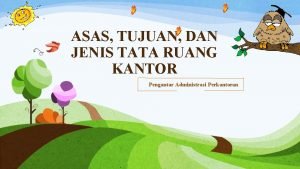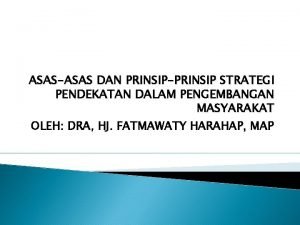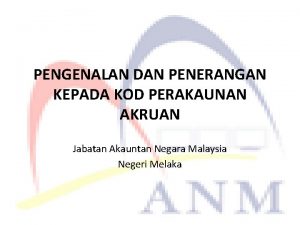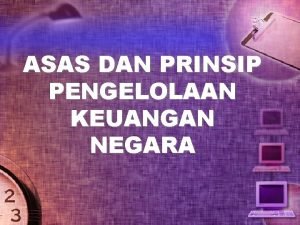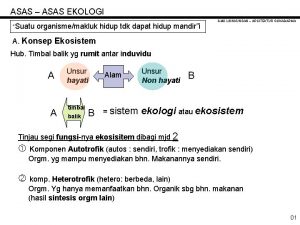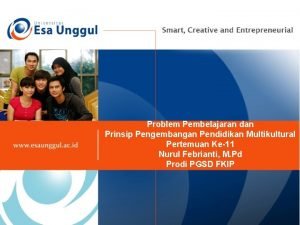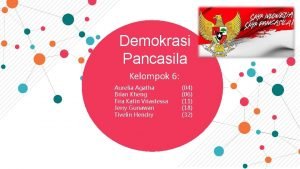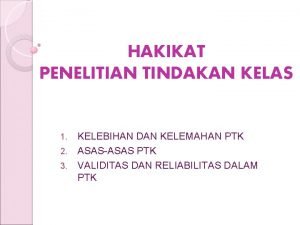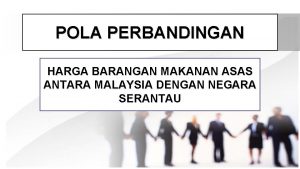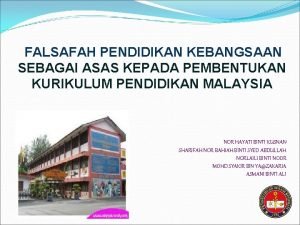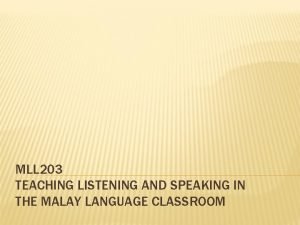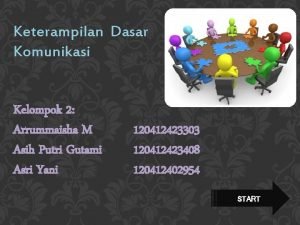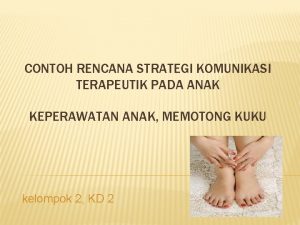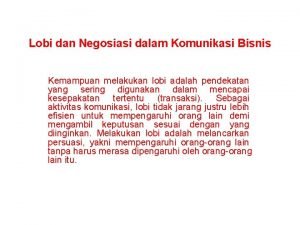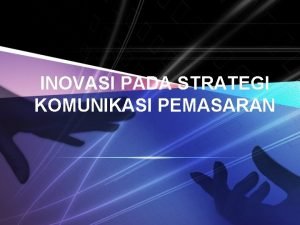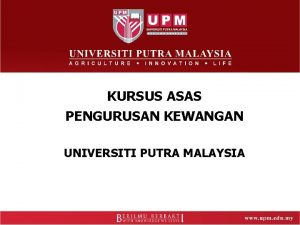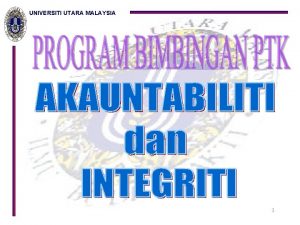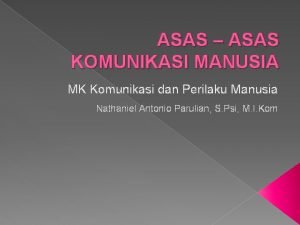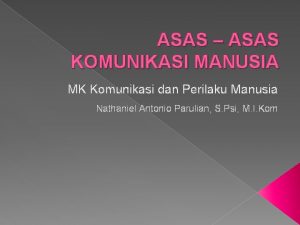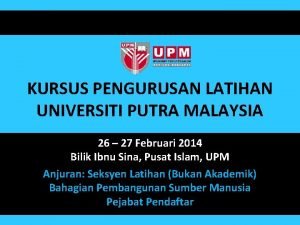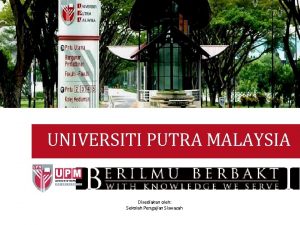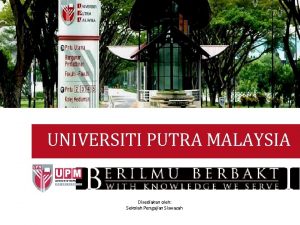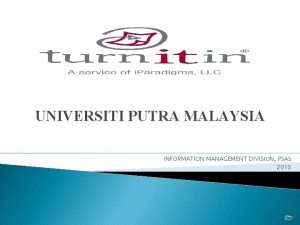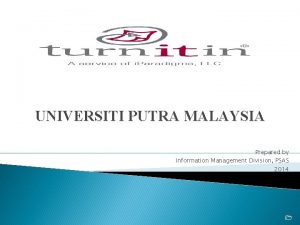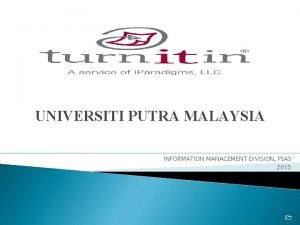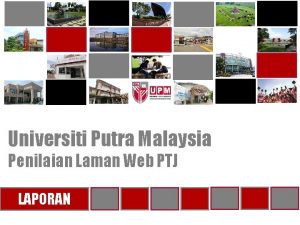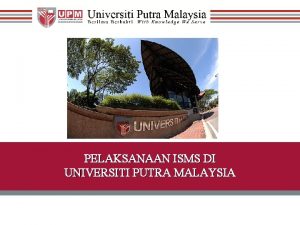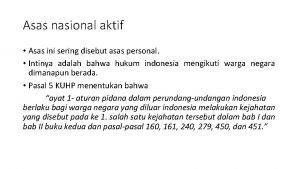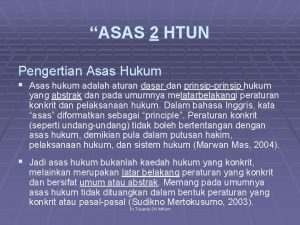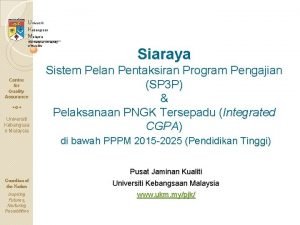ASAS STRATEGI KOMUNIKASI PPL Universiti Putra Malaysia CONTENTS

























![P’ciples of I/viewing: Types of Questionnaires (page 250) n Open-ended [Primary / Secondary] – P’ciples of I/viewing: Types of Questionnaires (page 250) n Open-ended [Primary / Secondary] –](https://slidetodoc.com/presentation_image_h2/8356e9e1bb8599ff90c18ce254b63f97/image-26.jpg)





- Slides: 31

ASAS STRATEGI KOMUNIKASI PPL Universiti Putra Malaysia

CONTENTS UNITS: n I: Introduction to Comm in Organ n II: Basic Comm Skills n III: ITP Comm Strategies n IV: Group Comm Strategies n V: Public Presentation Strategies

Unit III

DETAILS OF UNIT III n ITP Comm Strategies n Ch 7: Work Relationships n Ch 8: Principles of Interviewing n Ch 9: Interview in Business Settings

ITP COMM STRATEGIES: Chapter 7 n Ch 7: Work Relationships n Important skills to maintain constructive r/ships with superiors, co-workers, customers, and others

Manager-Employee Relationships “Everyone has a boss!” n Basic ethics of comm n Refraining comments on sensitive issues n Straight forward & honest with everyone n n Avoiding delays & distortions of information. No personal gain/ manipulation Stick to organiz-l goal esp during conflict

Manager-Employee Relationships “Everyone has a boss!” n Goal-setting n n Friendliness, Openness, Cooperation, Honesty. Situational Knowledge: Comm Climate: n n EFFECTIVE MNGRS: Approachable, Sensitive, Credible, Confident, Honest, Supportive. EFFECTIVE EMPLYEES: Performing the best, Pressure proof, Cooperative, Supportive, Honest, Promote boss’s & company’s success

Manager-Employee Relationships “Everyone has a boss!” n Methods of Managing Power n Assign on important tasks – esp. critical issues n Discretion & autonomy over tasks & resources n Visibility to others & recognition for efforts n Building r/ships for others, connecting with powerful people, finding sponsors, etc.

Co-worker Relationships “Capitalizing on individual strength!” n Coworkers are based upon: n Proximity n Shared interests n Shared tasks n Satisfaction of needs: n Support; Power; Expertise; Social interactions

Difficult person in our workplace! Who are they? "Sebarang individu / manusia yg bertindak keterlaluan dan menimbulkan ancaman jangka panjang dan jangka pendek dari segenap segi. ” –> tindakan, pandangan, perkataan, dll.

Individu bermasalah · Cara orang bermasalah berfikir: n Enggan memahami & menerima diversity. n Hanya pandangannya shj yg benar & tepat. n Fikiran golongan ini tertutup, negatif, skeptikal, prasangka, kusust, terdesak, putus asa, agresif, etc. n Semua yg baru, janggal & luar biasa ialah salah, silap & sesat – malah haram!. "

7 KATEGORI INDIVIDU BERMASALAH n n n n The Hostile aggressive The Complete complainer The Clamming-up The Ballooner Super Agreeable & nice The Negativist The Indecisive

'Hostile-aggressive‘ (ancam & agresif) Ciri-ciri: * Bertanya untuk memalukan * Nada suara yg keras, gaya yang angkuh * Kata 2 yg memperli, merendah 2 kan kita * Ambil kesempatan atas kelemahan kita.

'The Complete Complainer‘ (bersungut / complain) Ciri-ciri: * Sentiasa merungut biar apapun yang kita buat – sekalipun kesilapan kecil. * Sentiasa mempertahankan kesalahan & kelemahan dirinya dgn menyalahkan orang lain.

'Clamming Up' (pendiam) · Ciri-ciri: * Orang yg hanya diam ketika ditanyakan sesuatu maklumat yang mustahak. * Sentiasa berikan jawapan ringkas seperti: - "entah!", "Tak tahu", "Ok!".

'The Balloons‘ (menunjuk-nujuk pandai / hebat) · Ciri-ciri: *Bersikap demikian utk melindungi kekurangan diri. * Orang ini menolak pandangan orang lain * Rasakan hanya dia yang bagus.

Difficult Co-workers “Capitalizing on individual strength!” – suggested steps on page 213 1. Make sure you are not the one 2. Do your job 3. Fulfill the necessities of difficult person 4. Assess their perception levels 5. Accept them as is – not what you want them to be!

Difficult Co-workers “Capitalizing on individual strength!” – suggested steps on page 213 6. Confront them – wisely! 7. State how you feel – cautiously! 8. Recognize their achievements – deservingly! 9. Maintain your professionalism 10. Seek mediation – if all fails

Mentor – Protégé (page 222) n n n Mentor is usually older (years / knowledge / experience) from 8 to 15 years. Mentor must be: confident, approachable, successful, skillful in comm. , able to make decision, secure, strong ITP skills. Protégé must be: ambitious, eager to learn, open-minded, loyal, talented, energetic, communicative.

Mentor – Protégé phases (page 222) n n Initiation – appreciate the mentor’s talent and expertise Cultivation – ITP bonding in term of mutual admiration. Separation - Mentor & protégé needs some distance to be more independence. Redefinition – both see each other as peers (parallel but not equal!)

Addressing sexual harassment in workplace -page 228 As a victim: n n Be straight forward Immediately lodge a report to your boss/personnel. n Document each incident in details. n Bring up any witness (if any)

Addressing sexual harassment in workplace -page 228 As a supervisor: n Take every complaint seriously n Conduct your own investigation n Maintain objectivity n Suspend judgment – supervisor only supervise, let the judges pass the judgment!

ITP COMM STRATEGIES: Chapter 8 n Ch 8: Principles of I/viewing n “Your effectiveness in performing a task lies in your ability to reach others through your spoken word. ”

P’ciples of I/viewing n Important rules of asking questions: n Clarity in questioning n Relevance in questioning n Neutral & non-bias in questioning

P’ciples of I/viewing: Types of Questionnaires n Close-ended (yes or no) n Open-ended [Primary / Secondary]
![Pciples of Iviewing Types of Questionnaires page 250 n Openended Primary Secondary P’ciples of I/viewing: Types of Questionnaires (page 250) n Open-ended [Primary / Secondary] –](https://slidetodoc.com/presentation_image_h2/8356e9e1bb8599ff90c18ce254b63f97/image-26.jpg)
P’ciples of I/viewing: Types of Questionnaires (page 250) n Open-ended [Primary / Secondary] – 8 types: n Clarification-”Could you tell me a little more about. . ” n Elaboration-”Anything else you want to elaborate? ” n Paraphrase-“Let’s see, you were saying…” n Encouragement-“Uh. . huh! /That’s interesting” n Mirror-”You said that it’s important for you to have this job…” (using the respondents’ statement)

P’ciples of I/viewing n Responding & Providing F/back: n Attend with full preparation. n Concentrate on what you have to say n Listen!– never interrupt an incomplete question n Think before you speak- Don’t blurt out word/s n “An interviewee is worthy of an interviewer’s time. ”

ITP COMM STRATEGIES: n Ch 9: I/view in Biz Settings n “Your qualification will only get you an interview; your performance in the interview will get you the job!”

Interview in Business Settings n An Interviewee must know… n The goal setting –(i. e. ) “To get the job!” n Situational k’ledge – “Do some research!” n Prepare a CV that fit to the interview n Prepare a CV with a COVER LETTER! n Research on the Company’s background!

Interview in Business Settings n Communication Competence: n Dress appropriately n Prepare to ask & answer questions n Listen and utilize non-verbal comm skills n Handle discriminatory questions neutrally n Following up the interview – send a letter

Wassalamualaikum & Terima kasih
 Universiti putra malaysia
Universiti putra malaysia Pp ppl
Pp ppl Universiti yang menawarkan bidang psikiatri di malaysia
Universiti yang menawarkan bidang psikiatri di malaysia Gred pensyarah universiti awam
Gred pensyarah universiti awam Akta uitm 173
Akta uitm 173 Ayat menggunakan perkataan tatarias
Ayat menggunakan perkataan tatarias Apa maksud jam kredit
Apa maksud jam kredit Asas pramuka
Asas pramuka Pemusatan wewenang
Pemusatan wewenang A+b+c=a hubungan etnik
A+b+c=a hubungan etnik Pengertian asas asas bimbingan konseling
Pengertian asas asas bimbingan konseling Apa tujuan bentuk ruang kantor bertaman
Apa tujuan bentuk ruang kantor bertaman Asas asas pengembangan masyarakat
Asas asas pengembangan masyarakat Asas tunai ubahsuai
Asas tunai ubahsuai Bidang bidang dalam perusahaan
Bidang bidang dalam perusahaan Prinsip dasar pengelolaan keuangan negara
Prinsip dasar pengelolaan keuangan negara Etika menurut kbbi
Etika menurut kbbi Asas akruan maksud
Asas akruan maksud Asas ekologi
Asas ekologi Asas-asas dalam pendidikan multikultural
Asas-asas dalam pendidikan multikultural Asas asas demokrasi pancasila
Asas asas demokrasi pancasila Asas asas pemeliharaan karyawan
Asas asas pemeliharaan karyawan Asas asas perencanaan
Asas asas perencanaan Kelebihan dan kekurangan penelitian tindakan kelas
Kelebihan dan kekurangan penelitian tindakan kelas Pola perbandingan
Pola perbandingan Asas kurikulum
Asas kurikulum Malaysia malaysia malaysiansleereuters
Malaysia malaysia malaysiansleereuters Komunikasi bukan lisan
Komunikasi bukan lisan Mengaplikasikan keterampilan dasar komunikasi
Mengaplikasikan keterampilan dasar komunikasi Contoh komunikasi terapeutik pada anak
Contoh komunikasi terapeutik pada anak Bit.iy/persiapanobi
Bit.iy/persiapanobi Strategi komunikasi pemasaran terintegrasi
Strategi komunikasi pemasaran terintegrasi
